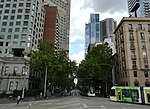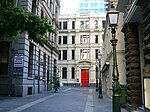Bank of New South Wales building, Melbourne

The Head Office building of The Bank of New South Wales was designed by prolific Melbourne architect Joseph Reed and constructed at 368–374 Collins St, Melbourne, in 1856–1857. Reed was awarded first prize, worth £75, in the Bank of New South Wales’ competition to design their new Melbourne headquarters on a vacant block of land facing the prominent Criterion Hotel. Reed's design was chosen for its extensive use of ornamentation on the relatively small scale building. The façade of the Bank of New South Wales building is prized as a leading example of mid nineteenth century Renaissance Revival architecture in Melbourne. Structural shortcomings and the desire for expansion led to the building's demolition in 1932. Reed's original National Trust heritage-listed façade was preserved and gifted to the University of Melbourne, where it can still be seen on the western face of the Melbourne School of Design, opposite Union Lawn.
Excerpt from the Wikipedia article Bank of New South Wales building, Melbourne (License: CC BY-SA 3.0, Authors, Images).Bank of New South Wales building, Melbourne
Collins Street, Melbourne Melbourne
Geographical coordinates (GPS) Address Nearby Places Show on map
Geographical coordinates (GPS)
| Latitude | Longitude |
|---|---|
| N -37.816361111111 ° | E 144.96227777778 ° |
Address
Collins Street 360
3000 Melbourne, Melbourne
Victoria, Australia
Open on Google Maps









